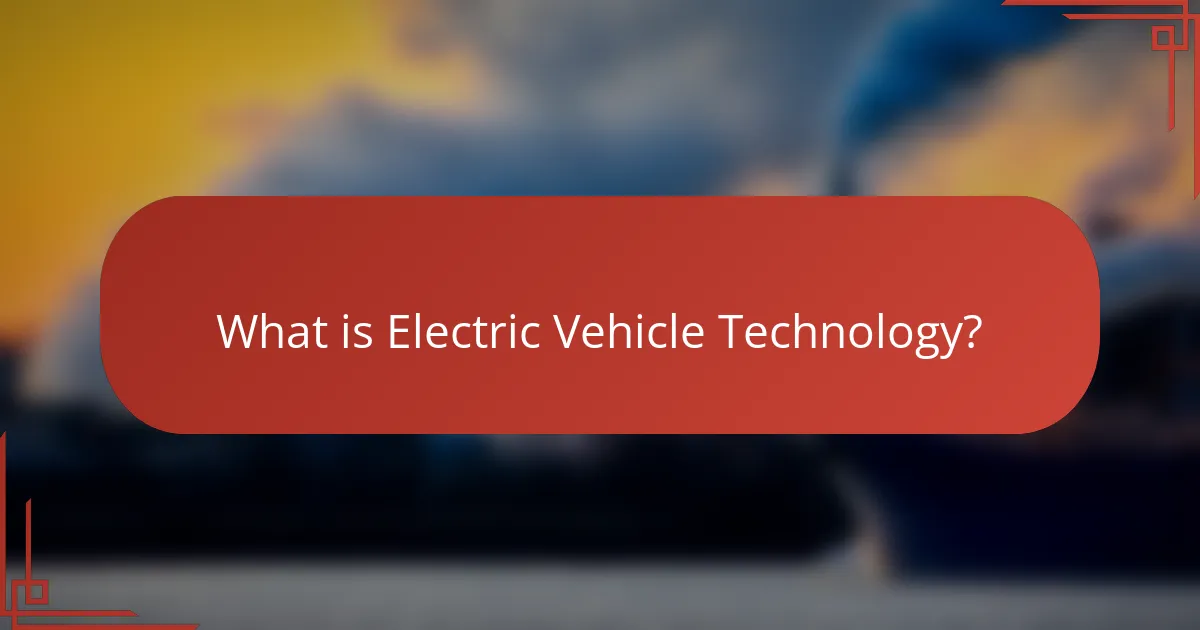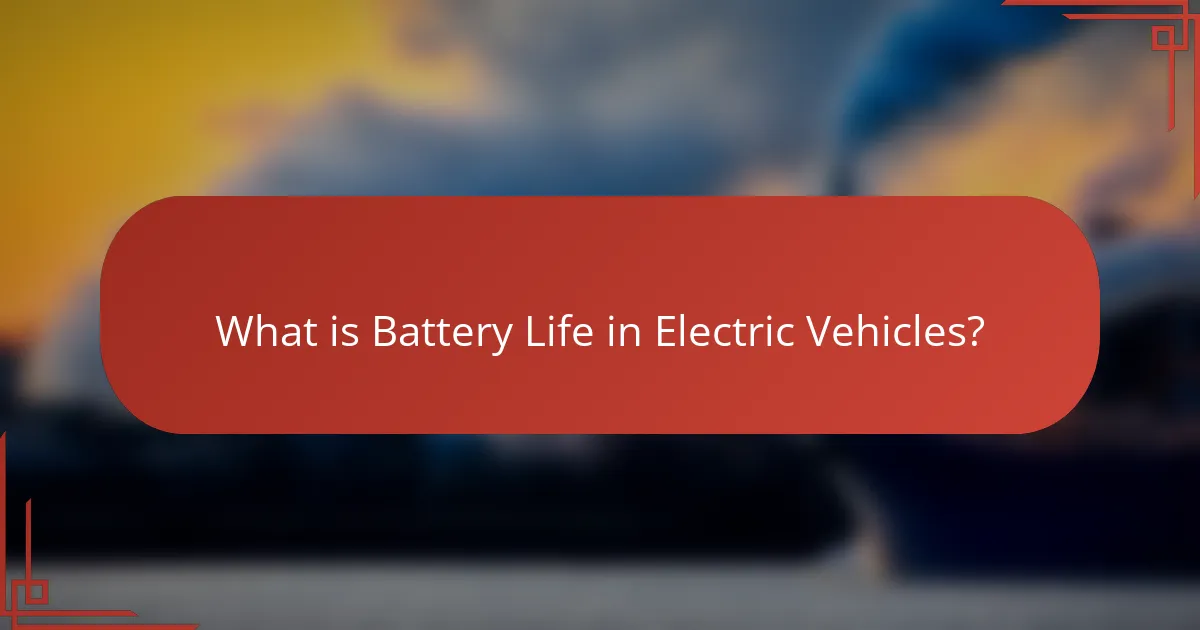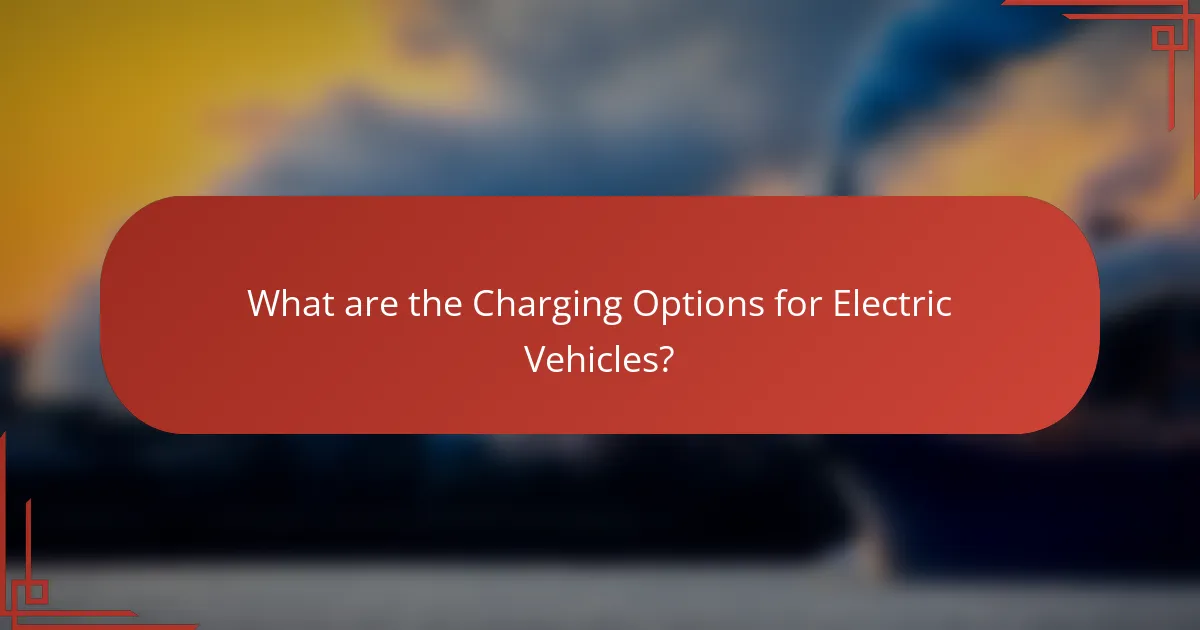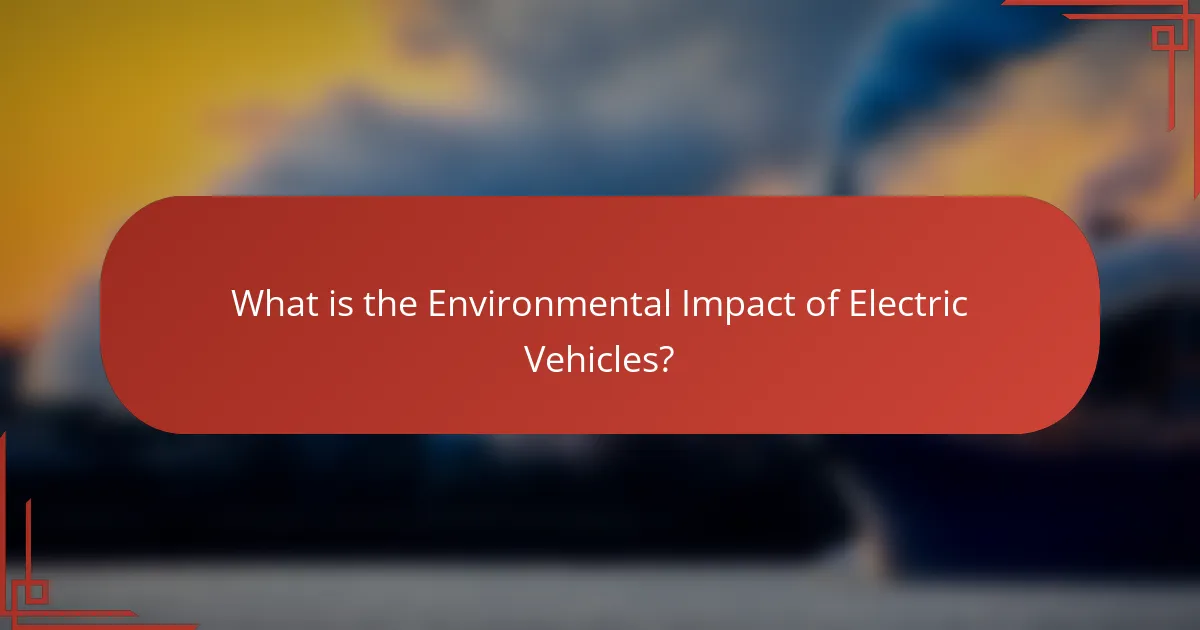Electric Vehicle Technology encompasses the systems and components that enable electric vehicles (EVs) to function effectively, including electric motors, batteries, and charging infrastructure. This article provides an overview of battery life, detailing how it is measured and the factors that influence it, such as driving habits and temperature. It also outlines the various charging options available for EVs, including Level 1, Level 2, and DC fast charging, which cater to different user needs and scenarios. Furthermore, the environmental impact of electric vehicles is examined, highlighting their role in reducing greenhouse gas emissions and improving air quality, as well as addressing the sustainability challenges associated with battery production and disposal.

What is Electric Vehicle Technology?
Electric Vehicle Technology refers to the systems and components that enable electric vehicles (EVs) to operate. This technology primarily includes electric motors, batteries, and charging infrastructure. Electric motors convert electrical energy into mechanical energy to drive the vehicle. Batteries store electrical energy for propulsion and power various vehicle systems. Charging infrastructure allows EVs to recharge their batteries, which can be done at home or public charging stations. According to the International Energy Agency, the global electric vehicle stock surpassed 10 million in 2020, indicating rapid adoption and technological advancement in this field.
How do electric vehicles differ from traditional vehicles?
Electric vehicles (EVs) differ from traditional vehicles primarily in their power source. EVs are powered by electric motors and batteries, while traditional vehicles rely on internal combustion engines fueled by gasoline or diesel. This fundamental difference leads to variations in performance, emissions, and maintenance needs.
EVs produce zero tailpipe emissions, contributing to reduced air pollution. In contrast, traditional vehicles emit greenhouse gases and pollutants during operation. Additionally, EVs typically have fewer moving parts, which can result in lower maintenance costs over time.
Charging infrastructure for EVs is also distinct. EVs require charging stations, which can be located at homes, workplaces, or public areas. Traditional vehicles can refuel at gas stations, which are more widely available.
Battery life in EVs varies but is often around 100,000 to 300,000 miles before degradation occurs. Traditional vehicles do not have such limitations related to battery life. Overall, these differences highlight the shift towards more sustainable transportation solutions with electric vehicles.
What are the key components of electric vehicle technology?
The key components of electric vehicle technology include the battery, electric motor, power electronics, and charging system. The battery stores energy and powers the vehicle. Lithium-ion batteries are commonly used due to their high energy density. The electric motor converts electrical energy into mechanical energy for propulsion. Power electronics manage the flow of electricity between the battery and motor. The charging system allows the vehicle to recharge its battery from an external power source. Together, these components enable efficient energy use and performance in electric vehicles.
How does electric vehicle technology impact performance?
Electric vehicle technology significantly enhances performance through instant torque delivery. This characteristic allows electric vehicles (EVs) to accelerate faster than traditional internal combustion engine vehicles. EVs utilize electric motors, which provide maximum torque from a standstill. This results in quicker starts and improved responsiveness. Additionally, electric vehicles often have a lower center of gravity due to battery placement. This design feature contributes to better handling and stability. Furthermore, advancements in battery technology have led to increased energy density. Higher energy density translates to longer ranges and improved overall efficiency. Studies show that electric vehicles can outperform gasoline vehicles in various performance metrics, including acceleration and handling.
What are the primary types of electric vehicles?
The primary types of electric vehicles are Battery Electric Vehicles (BEVs), Plug-in Hybrid Electric Vehicles (PHEVs), and Hybrid Electric Vehicles (HEVs). BEVs operate solely on electric power from batteries. They do not use any gasoline or diesel fuel. PHEVs combine a traditional internal combustion engine with an electric motor. They can run on electric power alone for a limited range before switching to gasoline. HEVs also use both an electric motor and a gasoline engine. However, HEVs cannot be plugged in to charge; they rely on regenerative braking and the internal combustion engine for battery charging. These classifications help consumers understand the various options available in the electric vehicle market.
What is the difference between battery electric vehicles and plug-in hybrids?
Battery electric vehicles (BEVs) run solely on electricity, while plug-in hybrids (PHEVs) combine an electric motor with a gasoline engine. BEVs are powered entirely by rechargeable batteries and produce zero tailpipe emissions. PHEVs can operate on electric power for a limited range before switching to gasoline. BEVs require charging from external sources, whereas PHEVs can be charged and also refuel at gas stations. According to the U.S. Department of Energy, BEVs typically have a longer electric-only range compared to PHEVs. Additionally, BEVs usually offer more efficient energy use compared to the dual power sources in PHEVs.
How do fuel cell electric vehicles operate?
Fuel cell electric vehicles (FCEVs) operate by converting hydrogen gas into electricity. This process occurs within a fuel cell stack. The fuel cell combines hydrogen from the vehicle’s tank with oxygen from the air. This reaction produces electricity, water, and heat. The electricity powers the vehicle’s electric motor. FCEVs emit only water vapor as exhaust. According to the U.S. Department of Energy, FCEVs can achieve a range comparable to conventional gasoline vehicles. They typically refuel in about five minutes, similar to traditional fuel refilling.
What are the key benefits of electric vehicles?
Electric vehicles (EVs) offer several key benefits. They produce zero tailpipe emissions, which helps reduce air pollution. This contributes to improved public health and environmental quality. EVs are also more energy-efficient than traditional vehicles. They convert about 60% of electrical energy from the grid to power at the wheels. In contrast, conventional gasoline vehicles only convert about 20% of the energy stored in gasoline. Additionally, EVs have lower operating costs. The average cost of electricity for EVs is significantly less than gasoline. Maintenance costs are also lower since EVs have fewer moving parts. Furthermore, many governments provide incentives for EV purchases. These incentives can include tax credits and rebates. Overall, the benefits of electric vehicles contribute to a more sustainable and cost-effective transportation solution.
How do electric vehicles contribute to reducing emissions?
Electric vehicles contribute to reducing emissions by eliminating tailpipe emissions. Unlike traditional gasoline vehicles, electric vehicles (EVs) produce no emissions during operation. This leads to improved air quality, especially in urban areas. Additionally, when charged from renewable energy sources, EVs can significantly lower overall greenhouse gas emissions. According to the U.S. Department of Energy, electric vehicles can reduce emissions by 50% or more compared to conventional vehicles. The transition to EVs also encourages the development of cleaner energy infrastructure. This shift further supports emission reduction goals on a larger scale.
What are the economic advantages of using electric vehicles?
Electric vehicles (EVs) offer significant economic advantages. They typically have lower operating costs compared to traditional gasoline vehicles. EVs benefit from reduced fuel expenses, as electricity is cheaper than gasoline. According to the U.S. Department of Energy, the cost to drive an electric vehicle is about half that of a gasoline vehicle.
Additionally, EVs require less maintenance due to fewer moving parts. This can lead to savings on repairs and servicing. Many regions provide tax incentives and rebates for EV purchases, further lowering the initial cost.
Furthermore, electric vehicles contribute to reduced air pollution, which can decrease healthcare costs associated with pollution-related illnesses. Studies indicate that widespread EV adoption could save billions in public health costs. Overall, the economic advantages of electric vehicles are substantial, encompassing lower operating costs, maintenance savings, tax incentives, and public health benefits.

What is Battery Life in Electric Vehicles?
Battery life in electric vehicles refers to the duration that an electric vehicle’s battery can provide power before needing a recharge. Typically, battery life is measured in miles or kilometers driven on a full charge. Most modern electric vehicles have a battery life ranging from 150 to over 370 miles per charge. Factors affecting battery life include driving habits, terrain, and temperature. For instance, aggressive acceleration and high speeds can reduce battery life. Additionally, cold weather can decrease battery efficiency. The average lifespan of electric vehicle batteries is around 8 to 15 years, depending on usage and care. Studies show that battery management systems can help optimize battery life.
How is battery life measured in electric vehicles?
Battery life in electric vehicles is measured in kilowatt-hours (kWh). This unit indicates the total energy capacity of the battery. A higher kWh rating generally means a longer driving range. Battery life can also be assessed through cycles, which represent the number of complete charge and discharge processes. Manufacturers often provide an estimated range based on energy consumption per mile. For instance, a vehicle consuming 0.3 kWh per mile with a 60 kWh battery could theoretically travel 200 miles on a full charge. Additionally, battery longevity is affected by factors such as temperature, charging habits, and usage patterns. Understanding these metrics helps consumers evaluate the efficiency and performance of electric vehicles.
What factors influence the lifespan of electric vehicle batteries?
The lifespan of electric vehicle batteries is influenced by several key factors. Temperature plays a crucial role; extreme heat or cold can degrade battery performance. Charging habits also impact lifespan; frequent fast charging can lead to faster wear. Depth of discharge is another factor; regularly depleting the battery to low levels can shorten its life. Battery management systems help optimize performance and longevity by monitoring health. Additionally, the quality of the battery materials affects durability; higher quality cells tend to last longer. Lastly, usage patterns, such as driving conditions and frequency of use, can influence battery aging. Studies indicate that optimal charging practices and moderate temperatures can extend battery life significantly.
How do temperature and charging habits affect battery performance?
Temperature and charging habits significantly impact battery performance. High temperatures can accelerate battery degradation. This leads to reduced capacity and overall lifespan. Conversely, low temperatures can decrease battery efficiency and range. Charging habits also play a crucial role. Frequent fast charging can generate excess heat, harming the battery. Maintaining a moderate charge level, ideally between 20% and 80%, helps optimize battery health. Studies show that batteries charged at lower temperatures perform better over time. Proper management of these factors can enhance battery longevity and performance.
What are the different types of batteries used in electric vehicles?
Electric vehicles primarily use lithium-ion batteries, nickel-metal hydride batteries, and solid-state batteries. Lithium-ion batteries are the most common type due to their high energy density and efficiency. They typically offer a range of 100 to 370 miles per charge. Nickel-metal hydride batteries are less common but are known for their durability and longer life cycles. Solid-state batteries are an emerging technology with the potential for higher safety and energy density. Their development is ongoing, and they could revolutionize electric vehicle performance. Each type of battery has unique attributes that affect vehicle range, charging time, and overall efficiency.
What are lithium-ion batteries and why are they popular?
Lithium-ion batteries are rechargeable energy storage devices that use lithium ions to transfer energy between the anode and cathode. They are popular due to their high energy density, which allows for longer usage times in smaller sizes. Lithium-ion batteries also have a low self-discharge rate, meaning they retain their charge longer when not in use. Their lightweight nature makes them ideal for portable electronics and electric vehicles. Additionally, they support fast charging, which enhances user convenience. The global market for lithium-ion batteries is projected to grow significantly, driven by the increasing demand for electric vehicles and renewable energy storage solutions.
How do solid-state batteries compare to traditional batteries?
Solid-state batteries offer several advantages over traditional batteries. They typically have a higher energy density, which allows for longer-lasting power. Solid-state batteries are also safer, as they are less prone to leakage and thermal runaway. Traditional batteries often use liquid electrolytes that can be flammable. Additionally, solid-state batteries can have a longer lifespan, potentially lasting over 2,000 charge cycles compared to 500-1,500 for traditional lithium-ion batteries. Their faster charging times are another benefit, with some solid-state designs capable of charging in under 30 minutes. These advantages make solid-state batteries a promising alternative in electric vehicle technology.
What strategies can enhance battery longevity?
To enhance battery longevity, implement several key strategies. Maintain a charge level between 20% and 80%. This practice helps to reduce stress on the battery. Avoid exposing the battery to extreme temperatures. High heat can accelerate degradation, while extreme cold can impair performance. Use a smart charging system to optimize charging cycles. This technology can prevent overcharging and excessive discharging. Regularly update the vehicle’s software. Manufacturers often release updates that improve battery management. Minimize fast charging when possible. Frequent fast charging can generate heat and shorten lifespan. Lastly, store the battery at a moderate charge level if not in use. This approach prevents deep discharge and keeps the battery healthy.
How can users optimize charging practices for better battery health?
Users can optimize charging practices for better battery health by following specific guidelines. First, avoid charging to 100% regularly. Keeping battery levels between 20% and 80% can extend lifespan. Second, use a slow charger when possible. Fast charging generates heat, which can degrade battery health over time. Third, avoid letting the battery fully discharge. Deep discharges can harm lithium-ion batteries. Fourth, charge in cooler environments. High temperatures during charging can accelerate wear. Fifth, unplug the charger once the battery reaches the desired level. Overcharging can lead to increased heat and stress. According to studies, maintaining optimal charge levels can significantly enhance battery longevity. Following these practices can help users maximize their electric vehicle battery performance.
What maintenance tips are essential for electric vehicle batteries?
To maintain electric vehicle batteries effectively, keep the battery charged between 20% and 80%. This range helps prolong battery life. Avoid frequent deep discharges as they can degrade battery health. Use a level 2 charger for regular charging to reduce charging time and heat. Monitor battery temperature; extreme heat or cold can negatively affect performance. Regularly update the vehicle’s software for optimal battery management. Store the vehicle in a climate-controlled environment when not in use for extended periods. Following these tips can enhance battery longevity and efficiency.

What are the Charging Options for Electric Vehicles?
Electric vehicles (EVs) can be charged through several options. The primary charging options include Level 1, Level 2, and DC fast charging.
Level 1 charging uses a standard household outlet, providing about 4-5 miles of range per hour. This method is convenient for overnight charging at home.
Level 2 charging requires a dedicated charging station. It can provide 10-60 miles of range per hour, depending on the vehicle and charger capacity. This option is common in public charging stations and at home installations.
DC fast charging is the quickest option, offering 60-100 miles of range in just 20-30 minutes. This method is typically found along highways for long-distance travel.
According to the U.S. Department of Energy, there are over 100,000 charging stations across the United States, supporting various charging options for EV users.
What types of charging stations are available for electric vehicles?
There are three main types of charging stations available for electric vehicles: Level 1, Level 2, and DC Fast Charging. Level 1 charging uses a standard 120-volt outlet. It typically provides 2 to 5 miles of range per hour of charging. Level 2 charging requires a 240-volt outlet. It can deliver 10 to 60 miles of range per hour, depending on the vehicle and station. DC Fast Charging utilizes high-voltage direct current. It can charge an electric vehicle to 80% in 20 to 30 minutes. These charging options cater to different needs and charging speeds for electric vehicle users.
What is the difference between Level 1, Level 2, and DC fast charging?
Level 1 charging uses a standard 120-volt outlet and provides about 4-5 miles of range per hour. Level 2 charging operates on a 240-volt outlet, delivering 10-60 miles of range per hour depending on the power level. DC fast charging utilizes direct current and can provide 60-100 miles of range in just 20-30 minutes. The primary difference lies in the voltage and charging speed. Level 1 is the slowest, suitable for overnight charging at home. Level 2 is faster, ideal for home and public charging stations. DC fast charging is the quickest option, often found at highway stations for long-distance travel.
How do home charging setups compare to public charging stations?
Home charging setups offer convenience and cost-effectiveness compared to public charging stations. Home charging allows users to charge their electric vehicles overnight, ensuring a full battery each morning. In contrast, public charging stations may require waiting times, especially during peak hours. According to the U.S. Department of Energy, home charging can cost significantly less per kilowatt-hour than using public stations. Additionally, home setups can utilize solar energy, further reducing costs and environmental impact. Public charging stations, however, provide the benefit of fast charging options, which can be essential during long trips. Overall, home charging is more suitable for daily use, while public stations serve as a valuable resource for longer journeys.
How long does it take to charge an electric vehicle?
Charging an electric vehicle typically takes between 30 minutes to 12 hours. The duration depends on the charging method used. Fast chargers can charge a vehicle to 80% in about 30 minutes. Level 2 chargers usually take 4 to 8 hours for a full charge. Standard household outlets may require 8 to 12 hours for a complete charge. Factors like battery size and charger power output also influence charging time. For example, a 60 kWh battery on a Level 2 charger will take approximately 8 hours to fully charge. These times can vary based on vehicle model and battery condition.
What factors affect charging time for electric vehicles?
Charging time for electric vehicles is influenced by several key factors. The power output of the charging station is a primary factor. Higher power levels reduce charging time. The vehicle’s battery capacity also plays a significant role. Larger batteries require more time to charge fully. Additionally, the state of charge affects charging duration. A battery that is nearly empty will charge faster than one that is partially full. Ambient temperature impacts charging efficiency as well. Cold temperatures can slow down the charging process. Furthermore, the vehicle’s onboard charger limits the maximum charging speed. Each vehicle has a specific charging capacity that cannot be exceeded. Lastly, the type of charging connector used can also affect charging time. Different connectors have varying power transfer capabilities.
How can users plan for charging during long trips?
Users can plan for charging during long trips by identifying charging stations along their route. They should use mapping apps that show available charging locations. Planning ahead helps avoid running out of battery. Users can also check the charging speed of stations. Fast chargers can significantly reduce downtime. It’s essential to consider the vehicle’s range and charging needs. Keeping a charging cable and adapter handy is advisable. Monitoring battery levels during the trip ensures timely stops for charging.
What are the benefits of using different charging options?
Different charging options provide flexibility and convenience for electric vehicle (EV) users. They allow users to charge at home, work, or public stations. Home charging is often the most cost-effective and convenient option. It enables overnight charging, ensuring vehicles are ready for use each day. Public charging stations offer rapid charging solutions, reducing downtime during long trips. Fast chargers can replenish up to 80% of battery capacity in about 30 minutes. Additionally, diverse charging options can optimize energy use based on time-of-day rates. This can lead to lower electricity costs. Overall, the availability of various charging options enhances the overall EV ownership experience.
How does fast charging impact the convenience of electric vehicle ownership?
Fast charging significantly enhances the convenience of electric vehicle ownership. It reduces the time needed to recharge an electric vehicle’s battery. For example, fast chargers can replenish up to 80% of a battery in approximately 30 minutes. This efficiency allows drivers to minimize downtime during long trips. Additionally, widespread availability of fast charging stations increases accessibility. Drivers can quickly charge their vehicles at key locations, such as highways and urban areas. According to a study by the International Council on Clean Transportation, fast charging infrastructure is essential for increasing electric vehicle adoption. The convenience of fast charging ultimately makes electric vehicles more practical for daily use and long-distance travel.
What are the cost implications of different charging methods?
Different charging methods for electric vehicles have varied cost implications. Home charging typically incurs lower costs, averaging around $0.13 per kWh in the U.S. Public charging stations can range from $0.20 to $0.60 per kWh, depending on the location and provider. Fast charging methods, while convenient, can be more expensive, sometimes exceeding $0.80 per kWh.
Additionally, some networks offer subscription models, which may reduce costs for frequent users. According to the U.S. Department of Energy, the average cost of charging an electric vehicle at home is significantly lower than at public stations. This cost variation affects overall ownership expenses, with home charging being the most economical option for most users.

What is the Environmental Impact of Electric Vehicles?
Electric vehicles (EVs) have a significant environmental impact, primarily through reduced greenhouse gas emissions. Studies show that EVs produce less CO2 over their lifecycle compared to traditional gasoline vehicles. For instance, a 2020 report by the Union of Concerned Scientists indicates that EVs generate less than half the emissions of new gasoline cars over 20 years.
Additionally, the production of EV batteries can result in environmental concerns, including resource extraction and manufacturing emissions. However, advancements in battery technology are improving sustainability. Recycling programs for EV batteries are also being developed to minimize waste.
In terms of air quality, EVs contribute to lower levels of pollutants in urban areas. The U.S. Environmental Protection Agency notes that transitioning to EVs can significantly reduce harmful emissions like nitrogen oxides and particulate matter. Overall, the shift to electric vehicles presents both challenges and benefits for the environment.
How do electric vehicles affect overall greenhouse gas emissions?
Electric vehicles (EVs) significantly reduce overall greenhouse gas emissions compared to traditional gasoline vehicles. EVs produce zero tailpipe emissions, which lowers air pollution in urban areas. The electricity used to charge EVs can come from renewable sources, further decreasing emissions. According to the Union of Concerned Scientists, EVs produce less than half the emissions of comparable gasoline cars over their lifetime. This includes emissions from manufacturing, charging, and disposal. Additionally, as the grid becomes greener, the emissions associated with EV charging will continue to decline. In contrast, gasoline vehicles consistently emit greenhouse gases throughout their operation. Thus, transitioning to electric vehicles is a crucial step in mitigating climate change.
What are the emissions associated with electric vehicle production?
Electric vehicle production is associated with significant greenhouse gas emissions. The manufacturing process, particularly of batteries, contributes a large portion of these emissions. Studies estimate that producing a typical electric vehicle emits around 15 to 68% more CO2 compared to a conventional gasoline vehicle. This increase is largely due to the energy-intensive processes involved in mining and processing materials like lithium, cobalt, and nickel for batteries. For instance, the International Council on Clean Transportation reported that battery production can produce up to 150 kg of CO2 per kWh of battery capacity. Overall, while electric vehicles reduce emissions during operation, their production phase has a notable environmental impact.
How does the source of electricity influence the environmental impact?
The source of electricity significantly influences environmental impact. Renewable sources like solar and wind produce minimal emissions. In contrast, fossil fuels release greenhouse gases during combustion. For example, coal-fired plants emit about 2.2 pounds of CO2 per kilowatt-hour generated. This contributes to climate change and air pollution. Hydropower has a lower carbon footprint but can disrupt local ecosystems. The energy mix determines the overall emissions associated with electric vehicle charging. A cleaner energy grid reduces the environmental impact of electric vehicles.
What are the lifecycle impacts of electric vehicles?
The lifecycle impacts of electric vehicles (EVs) include manufacturing, operation, and end-of-life disposal effects. Manufacturing EVs generally requires more energy and resources than traditional vehicles. This is primarily due to the production of lithium-ion batteries. The extraction of lithium, cobalt, and nickel for these batteries can lead to environmental degradation.
During operation, EVs produce zero tailpipe emissions. This significantly reduces air pollution compared to internal combustion engine vehicles. The overall emissions depend on the electricity source used for charging. Renewable energy sources minimize the carbon footprint during the vehicle’s use phase.
At the end of their lifecycle, EV batteries can be recycled. Recycling can recover valuable materials and reduce the need for new resource extraction. However, the recycling infrastructure is still developing, which can limit the effectiveness of this process.
Studies indicate that the total greenhouse gas emissions of EVs are lower over their entire lifecycle compared to conventional vehicles. According to the Union of Concerned Scientists, EVs produce less than half the emissions of comparable gasoline-powered cars over their lifetime.
How do electric vehicles compare to traditional vehicles over their lifespan?
Electric vehicles (EVs) generally have lower lifetime costs compared to traditional vehicles. EVs have fewer moving parts, leading to reduced maintenance expenses. They also benefit from lower fuel costs since electricity is typically cheaper than gasoline. Studies show that EVs can save owners approximately $4,600 over their lifespan in fuel and maintenance.
In terms of lifespan, EV batteries are designed to last around 8 to 15 years, with many manufacturers offering warranties up to 100,000 miles. Traditional vehicles, however, often require more frequent repairs and replacements.
Environmental impact also favors EVs. They produce zero tailpipe emissions, contributing less to air pollution over their lifespan. According to the Union of Concerned Scientists, EVs can reduce greenhouse gas emissions by up to 50% compared to gasoline vehicles.
The total cost of ownership for EVs is often lower due to incentives and tax credits available in many regions. Overall, EVs offer significant advantages in cost, maintenance, and environmental sustainability over their lifespan compared to traditional vehicles.
What are the recycling options for electric vehicle batteries?
Recycling options for electric vehicle batteries include various methods such as mechanical recycling, hydrometallurgical recycling, and pyrometallurgical recycling. Mechanical recycling involves shredding the batteries to separate materials like metals and plastics. Hydrometallurgical recycling uses chemical processes to extract valuable metals. Pyrometallurgical recycling involves high-temperature smelting to recover metals. These processes help recover up to 95% of valuable materials. The growing need for sustainable battery disposal is supported by regulations and initiatives promoting recycling. According to the International Energy Agency, the demand for battery recycling will increase as electric vehicle adoption rises.
What steps can be taken to maximize the environmental benefits of electric vehicles?
To maximize the environmental benefits of electric vehicles, several steps can be taken. First, utilizing renewable energy sources for charging is essential. This reduces carbon emissions associated with electricity generation. Second, encouraging efficient driving habits can enhance energy conservation. Studies show that smooth acceleration and braking can improve range. Third, investing in recycling programs for batteries is crucial. Recycling lithium-ion batteries can recover valuable materials and reduce waste. Fourth, expanding charging infrastructure supports widespread adoption. Accessible charging stations can encourage more users to switch to electric vehicles. Finally, promoting public transportation options can reduce individual car usage. This shift decreases overall emissions and traffic congestion.
How can users choose renewable energy sources for charging?
Users can choose renewable energy sources for charging by evaluating local energy providers. Many utility companies offer green energy options sourced from wind, solar, or hydroelectric power. Users should check if their provider has a program that allows them to select renewable sources. Research shows that using renewable energy can reduce carbon emissions associated with charging electric vehicles. Additionally, users can install solar panels at home to generate their own renewable energy. This can lead to lower electricity bills and increased energy independence. Choosing renewable energy contributes to a sustainable environment and supports the transition to clean energy.
What role do government policies play in promoting electric vehicle adoption?
Government policies play a crucial role in promoting electric vehicle (EV) adoption. They provide incentives such as tax credits and rebates for consumers purchasing EVs. These financial incentives lower the overall cost of EV ownership. Policies also include investment in charging infrastructure, making it more accessible for users. Additionally, regulations on emissions encourage manufacturers to produce more EVs. Some governments set targets for EV sales, creating a market demand. For example, California’s Zero Emission Vehicle program mandates a certain percentage of sales to be electric. These combined efforts significantly contribute to increasing EV adoption rates.
What are some best practices for electric vehicle owners?
Electric vehicle owners should regularly charge their vehicles to maintain battery health. Keeping the battery charged between 20% and 80% can extend its lifespan. Owners should also utilize home charging stations for convenience and cost savings. Public charging stations should be used when necessary, especially during long trips.
Maintaining proper tire pressure is crucial for optimal efficiency. Regularly checking and maintaining tire pressure can improve range. Owners should also schedule routine maintenance checks to ensure all systems function correctly.
Using regenerative braking can help recharge the battery while driving. This feature enhances efficiency and can increase overall range. Lastly, staying updated on software updates can enhance vehicle performance and safety features.
How can electric vehicle owners contribute to sustainability efforts?
Electric vehicle owners can contribute to sustainability efforts by reducing greenhouse gas emissions. Electric vehicles (EVs) produce zero tailpipe emissions, which helps improve air quality. According to the U.S. Department of Energy, EVs can reduce carbon dioxide emissions by up to 60% compared to traditional gasoline vehicles. Owners can also participate in renewable energy programs. Charging EVs with renewable energy sources like solar or wind further decreases their environmental impact. Additionally, EV owners can promote sustainable practices by sharing their experiences and encouraging others to switch to electric. This collective action can lead to a larger shift towards sustainable transportation solutions.
What tips can help new electric vehicle owners maximize their experience?
New electric vehicle owners can maximize their experience by understanding charging options. Familiarize yourself with home charging setups. Install a Level 2 charger for faster charging times. Utilize public charging stations when traveling. Apps like PlugShare can help locate nearby chargers. Monitor battery health regularly to ensure optimal performance. Take advantage of regenerative braking to extend battery life. Join local EV communities for tips and support. Lastly, stay informed about software updates to enhance vehicle functionality.
Electric Vehicle Technology encompasses the systems and components that enable electric vehicles (EVs) to function, primarily focusing on electric motors, batteries, and charging infrastructure. The article details the differences between electric and traditional vehicles, key components of EV technology, types of electric vehicles, and the impact of battery life and charging options on performance. It also examines the environmental implications of EVs, including their contributions to reducing greenhouse gas emissions and the lifecycle impacts of production and disposal. Additionally, the article outlines strategies for optimizing battery longevity and charging practices, as well as the role of government policies in promoting electric vehicle adoption.


